![]()
![]()
![]()
Use LEFT and RIGHT arrow keys to navigate between flashcards;
Use UP and DOWN arrow keys to flip the card;
H to show hint;
A reads text to speech;
61 Cards in this Set
- Front
- Back
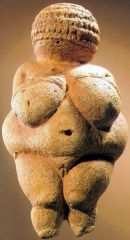
|
Venus of Willendorf, c. 28,000-21000 BCE., limestone
reproductive organs emphasized deemphasized arms, face, legs and no feet hair in clumps arranged in rows fertility symbol? small - ment to be handheld |
|
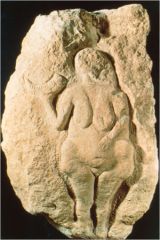
|
Woman Holding Bison Horn, from Laussel, France, ca. 25,000-20,000 BCE. Painted limestone, 1'6" high
freestanding, one of the earliest relief sculptures reproductive organs emphasized and left arm arm draws attention to the midsection and pubic area fertility symbol? meaning is debated featureless face |
|
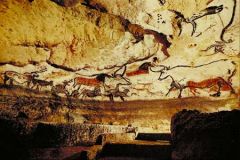
|
Lascaux Cave Painting, Hall of Bulls, France, ca. 15,000 - 13,000 BCE. Largest bull 11' 6" long
colored silhouettes and outlined differences in style and technique suggest painted at different times different animals running in different directions twisted perspective |
|

|
Bison, Altamira Spain, detail of a painting ceiling in the cave at Altamira, ca. 12,000 - 11,000 BCE. Each bison 5' long
no ground line or indication of setting - artist was representing animals and interaction not place in profile |
|

|
Bison with turned head, fragmentary spearthrower, from La Madeleine, France, ca. 12,000 BCE. Reindeer horn, 4" long
sculptor turn head to keep profile view detailed |
|

|
Spotted Horse, Pech-Merle, France, ca. 22,000 BCE. painting, 11' 2" long
painted hands - signatures of cult or community? horse might be inspired by rock formation |
|

|
Rhinoceros, wounded man, and disemboweled bison, painting in the well of the cave at Lascaux, France, ca. 15,000 - 13,000 BCE. Bison 3'8" long
two animals draw by different ppl? man less detailed then animals if paintings of 2 animals and bird-faced (masked?) man depict a hunting scene, they constitute the earliest example of narrative art ever discovered. |
|

|
Human figure with feline head, from Hohlenstein-Stadel, Germany, ca. 30,000 - 28,0000 BCE. Mammoth ivory, 11 5/8 " high
one of the oldest sculptures large ivory figure (important to maker) unknown if it depicts a composite creature or a human in mask represents something imagined? |
|

|
Two Bison, reliefs in a cave at Le Tuc d'Audobert, France, ca. 15,000 - 10,000 BCE. Clay, each 2' long
sculptor built these with a stone spatula-like smoothing tool and fingers to shape details strict profile largest Paleolithic sculptures known |
|

|
Deer Hunt, Catal Hoyuk, detail of a wall painting from Level III, Catal Hoyuk, Turkey, ca. 5750 BCE.
neolithic painter depicted human figures as a composite of frontal and profile views, the most descriptive picture of the shape of the human body exaggeration of movement |
|
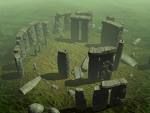
|
Stonehenge, c. 2100 B.C.E., Wiltshire, England
post-and-lintel / mortise-and-tenon building megaliths in center are over 20 feet + form a horseshoe around a flat stone some stones over 50 tons oriented toward sunrise on the longest day of the year ? ; may also predict eclipses |
|

|
Human figure, Ain Ghazal, Jordan, ca. 6750 - 6250 BCE. Plaster, painted and inlaid with bitumen, 3' 5 3/8" high
dozens of these things were found, some with two heads white plaster statuettes earliest large sculptures known ritually buried? |
|

|
Tell ASmar Statues, from the Square Temple at Eshnunna, Iraq, ca. 2700 BCE. Gypsum inlaid with shell and black limestone, male figure 2' 6" high
different heights, denoting hierarchy of scale hands folded in gesture of prayer eyes in awe - spellbound- staring at deity? men - bare upper chest; skirt waist down / women - dress draped over one shoulder figures represent mortals, placed in a temple and praying - to the god Abu? |
|

|
Warka Vase, from Uruk (modern Warka), Iraq, ca. 3200-3000 BCE. Alabaster, 3' 1/4" high
oldest known of sumerian narrative art registers break with the haphazard figure placement found in earlier art |
|

|
Standard of Ur, from tomb 779, Royal Cemetery, Ur (modern Tell Muqayyar), Iraq, ca. 2600 BCE. Wood inlaid with shell, lapis lazuli, and red limestone, 8' * 1' 7"
war side and peace side; two halves of narrative?; early example war side: sumerian king (taller) has descended from his chariot to inspect captives brought before him, some debased by their nakedness; chariots advance over the dead in lower register profile figures + broad frontal shoulders emphasis on eyes, eyebrows, ears |
|

|
Lyre-Sound Box, from tomb 789, Royal Cemetery, Ur, Iraq, ca. 2600 BCE
lyre: gold leaf and lapis lazuli over a wooden core, 5'5 high sound box: wood with inlaid gold, lapis lazuli, and shell, 1' 7" high lyre has bull head 4 registers? : 1st level- sumerian wrestling two-headed bulls, 2nd level - wolf carries a table with animal parts, preparing for a ceremony; lion bears wine, 3rd - donkey plays bull harp; bear dances, 4th - scorpion man animals in profile, frontal shoulders |
|
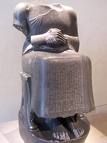
|
Seated Gudea, from Girsu, Iraq, ca. 2100 BCE. Diorite, 2' 5" high
folded hands; long fine fingers right arm bare broad shoulders, narrow waist, simple contours sense of calm, peaceful Diorite, an expensive stone, proclaims the wealth of the owner and importance of the subject |
|

|
Victory Stele of Naram-Sin, from Susa, Iran, 2254 - 2218 BCE. Pink sandstone, 6' 7" high
Naram-Sin defies himself as the composition leads him up the mountain to the heavens (stars) Victory blessed by the gods (sun) king wears horned crown of divinity, bow and arrow, battle axe in hollow arm defeated soldiers beg for mercy hierarchy of scale figures in composite view |
|

|
Stele code of Hammurabi, from Susa, Iran, ca. 1780 BCE. Basalt, 7' 4" high.
one of law codes ever written sun god handing hammurabi rope, ring, and rod of kingship shamash's beard is fuller stare at each other directly but shoulders are frontal with composite views 300 laws |
|
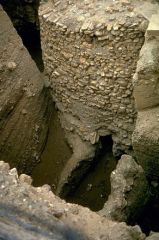
|
Jericho, Great stone tower built into the settlement wall, ca. 8000 - 7000 BCE.
Neolithic Jericho was protected by 5-foot-thick walls and at least one stone tower 30 feet high and 33 feet in diameter - an outstanding achievement that marks the beginning of monumental architecture defense system? |
|
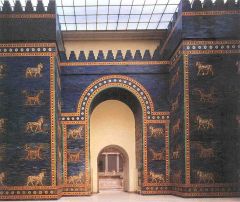
|
Ishtar Gate, Babylon, Iraq, ca. 575 BCE.
glazed brick covers mud walls of the city animals guard the entrance to the city lions sacred to the goddess ishtar crenellations give a warlike appearance to gate lions sacred to the goddess ishtar crenellations give a warlike appearance to gate |
|
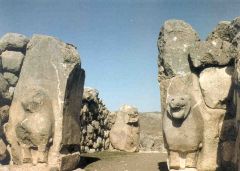
|
Lion Gate, Hattusa, Turkey, ca. 1400 BCE.
gate to city guardian lions massive impression mud brick |
|

|
Lamassu, from the citadel of Sargon II, Dur Sharrukin, Iraq, ca. 720 - 705 BCE. Limestone, 13' 10" high
5 legs: when seen from front seems to be standing at attention, from front seems to be walking by you meant to ward off enemies visible and invisible human-winged-animal |
|
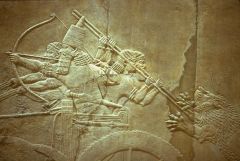
|
Lion Hunt, relief from the North Palace of Ashurbanipal, Nineveh, Iraq, ca. 645-640 BCE. Gypsum, 5' 4" high
one of oldest narratives emotions in animals - not humans ground line bold contours shows power over nature |
|
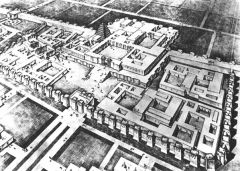
|
Palace of Sargon II, Dur Sharrukin, Iraq, ca. 720 - 705 BCE.
fortified walls enclosed courtyards, a throne room, service quarters, guard rooms, a great ziggurat, and six sanctuaries |
|
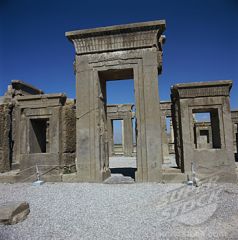
|
Palace at Perepolis, Iran, ca. 521- 465 BCE.
created by darius and xerxes... alexander destroyed it mud bricks and stone face lamassu gates relief sculptures depict delegations from all parts of the empire bringing gifts to be stored in the local treasury; Darius selected this central location in Persia to ensure protection of the treasury columns had a bell-shaped base that is an inverted lotus blossom, capitals are bulls or lions carved into the stairs are Immortals |
|
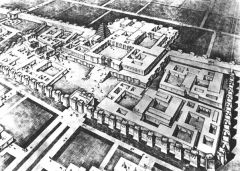
|
Palace of Shapur I, Ctesiphon, Iraq, ca. 250 CE.
built by Sassanian Persian rulers brick audience hall arches and barrel vault - Roman influence |
|
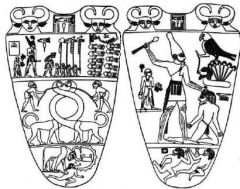
|
Palette of Narmer, from Hierakonpolis, Egypt, Predynastic, ca. 3000 - 2920 BCE. Slate, 2' 1"
King Narmer uniting upper and lower Egypt the god, Hathor, is depicted four times hierarchy of scale Narmer wears crowns of upper and lower Egypt lioness with elongated necks, symbolizing unification? hawk is Horus - God of Egypt bulls tail symbolizes strength |
|

|
Mortuary Precinct, Saqqara, Egypt, third Dynasty, ca. 2630 - 2611 BCE
pyramid was the centerpiece of an immense funerary complex that included a mortuary temple, other buildings, and courtyards. its network of underground galleries resembled a palace |
|
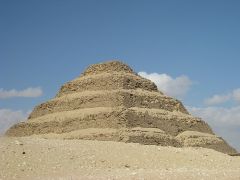
|
Stepped Pyramid of Imhotep, Saqqara, Egypt, third Dynasty, ca. 2630 - 2611 BCE
by Imhotep, 1st known artist six steps staircase to heaven? 1st complex of only stone burial is underground |
|
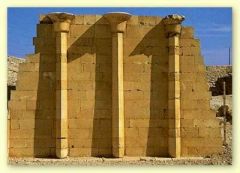
|
Detail of columns of the Djoser complex, Saqqara, Egypt, third Dynasty, ca. 2630 - 2611 BCE
engaged to the walls and have shafts and capitals resembling papyrus stalks and blossoms |
|
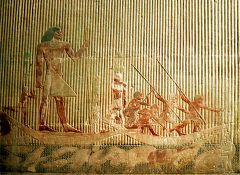
|
Ti Watching Hippo Hunt, relief in the mastaba of Ti, Saqqara, Egypt, Fifth Dynasty, ca. 2450 - 2350 BCE. Painted limestone, 4' high
Ti - government official glides through the papyri, which flower into a fan of birds and foxes hunt is memorial to the dead - fight against evil servants hunt hippopotami (pest) Ti is double everyones size |
|
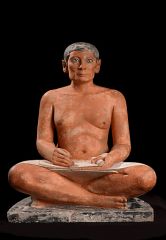
|
Seated Scribe, Saqqara, Eygypt, Fourth Dynasty, ca. 2500 BCE. Painted limestone, 1' 9" high
created as provision for the ka wooden sculpture n realistic features - not pharaoh conventional attentive expression |
|
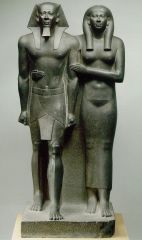
|
Menkaure and his wife, Gizeh, Egypt, Fourth Dynasty, ca. 2490 - 2472 BCE. Graywacke, 4' 6.5" high
the double portrait displays the conventional postures used for statues designed as substitute homes for the ka frozen gestures signify that the man and woman are married |
|
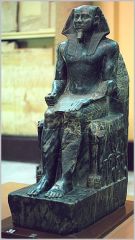
|
Khafre enthroned, Gizeh, Egypt, Fourth Dynasty, ca. 2520 - 2494 BCE. Diorite, 5'6" high
idealized falcon god behind him - incarnation - appointed interlocking of plants at bottom - symbol of united Egypt frontal, rigid, cubic, motionless, symmetrical not cut away from stone proportions |
|
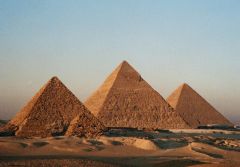
|
Great Pyramids of Giza, Egypt, Fourth Dynasty, Menkamure - ca. 2490 - 2472 BCE, Khafre - ca. 2520 - 2494 BCE, and Khufu, ca. 2551 - 2528 BCE
monuments to dead pharaohs - with mortuary temples buried in pyramid each side oriented toward a point on the compass |
|
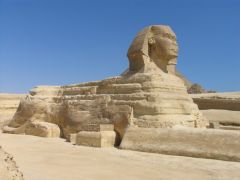
|
Sphinx, Gizeh, Egypt, Fourth Dynasty, ca. 2520 - 2494 BCE. Sandstone
body of a lion, head of god or pharaoh generalized features carved from rock protected by pyramids? cats are looked at as royal |
|
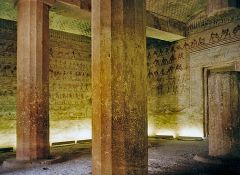
|
Interior of tomb of Amenemhet, Beni Hsan, Egypt, 12th Dynasty, ca. 1950 - 1900 BCE
columnar hall of tomb was carved out of the living rock - explains the suspended broken column at the rear shafts are fluted in a manner Greek architects later emulated |
|
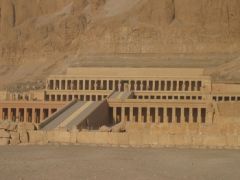
|
Temple of Hatshepsut, Deir el-Behri, Egypt, 18th Dynasty, ca. 1473 - 1458 BCE
3 colonnaded terraces and 2 ramps visually coordinated with the natural setting long horizontals and verticals of the terraces and colonnades repeat the patterns of the cliffs behind; patterns of dark and light in the colonnade are reflected in the cliffs terraces were originally planted as gardens with exotic trees 1st time achievements of a women are celebrated in art |
|
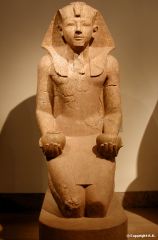
|
Hatshepsut with offering jars, Deir el-Behri, Egypt, 18th Dynasty, ca. 1473 - 1458 BCE, 8' 6" high
many portraits were destroyed after death this one was put together depicts the queen as a male pharaoh with false beard inscription calling her "His Majesty" |
|
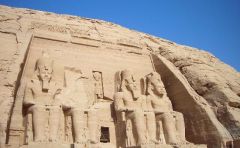
|
Temple of Rames II, Abu Simbel, Egypt, 19th Dynasty, ca. 1290 - 1224 BCE. Sandstone, colossi 65' high
rock-cut tomb resembles a pylon huge seated quartet of statues of Ramses on the facade, carved in situ sun god placed over the entrance facade at one time was brightly painted royal family located between Ramses' legs sun enters the center of the tomb on Ramses' birthday, October 21, lighting up his statue deep interior interior sculptures of Ramses are carved in reserve |
|
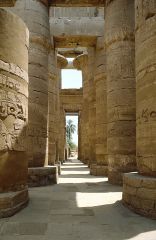
|
Hypostyle hall of Karnak, temple of Amen-Re, Egypt, 19th Dynasty, ca. 1290 - 1224 BCE
huge columns, tightly packed together, admitting little light into the sanctuary hypostyle halls columns elaborately painted Massive lintels bind the columns together Axial plan |
|
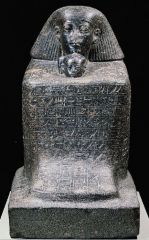
|
Senmut with Princess Nefrua, Thebes, Egypt, 18th Dynasty, ca. 1470 - 1460 BCE. Granite, 3' .5"
new kingdom block statues exhibit an even more radical simplification of form than do old kingdom statues Hatshepsut's chancellor holds the queen's daughter in his "lap" and envelops her in his cloak |
|
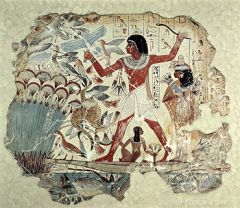
|
Fowling Scene, tomb of Nebamun, Thebes, Egypt, 18th Dynasty, ca. 1400 - 1350 BCE. Fresco on dry plaster, 2' 8" high
Nebamun's wife and daughter - depicted smaller than the deceased - accompany him on his hunt for fowl painted inscription states that Nebamun is enjoying recreation in his eternal afterlife |
|
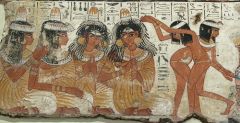
|
Musician and Dancers, tomb of Nebamun, Thebes, Egypt, 18th Dynasty, ca. 1400 - 1350 BCE. Fresco on dry plaster, 1' * 2' 3"
second fresco in Nebamun's tomb represents a funerary banquet in which the artist experimented with frontal views of faces and bodies - a relaxation of the old kingdom's stiff rules of representation |
|

|
Akhenaton, temple of Aton, Karnak, Egypt, 18th Dynasty, ca. 1353 - 1335 BCE. Sandstone, 13' high
body has same pose pose in old kingdom sculptures, but features are smoother, more relaxed; new image of a pharaoh curving contours, epicene body, slack lip, long face, heavy-lidded eyes tight clothes, big hips amarna style |
|
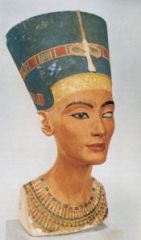
|
Nefertiti, Amarna, Egypt, 18th Dynasty, ca. 1353 - 1335 BCE. Painted limestone,1' 8" high
wife of akhenton long, elegant neck realistic face; soft, delicate new kingdom features demonstration model for copying? amarna style |
|
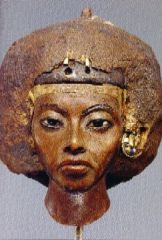
|
Tiye, Ghurab, Egypt, 18th Dynasty, ca. 1353 - 1335 BCE. Wood , with gold, silver, alabaster, and lapis lazuli, 3.75" high
portrait of Akhenaton's mother is carved of dark yew wood, probably to match the queen's complexion head was remodeled during her son's reign to remove all references to traditional deities |
|

|
Tutankhamen, Thebes, Egypt, 18th Dynasty, ca. 1323 BCE. Gold with inlay of enamel and semiprecious stones, 6' 1" long
famous tomb discovered by howard cater buried with 143 objects on him - gold mask gold coffin, with body idealized undulating curves replace rigid lines mood is informal circle - sun god |
|

|
Temple of Horus, Edufu, Egypt, ca. 237-47 BCE
same basic architecture scheme as the temple at Karnak |
|
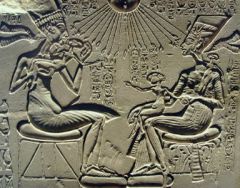
|
Akhenaton, Nefertiti, and three daughters, Amarna, Egypt, 18th Dynasty, ca. 1353 - 1335 BCE. Limestone, 1' 1/4" high
undulating curves replace rigid lines mood is informal circle - sun god |
|
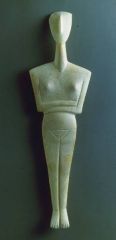
|
Cycladic female figures, Syros, Greece, ca. 2500 - 2300 BCE. Marble, 1' 6" high
nude women, arms folded about waists very thin figures with prominent heads meant to be on their backs wedge-shaped pelvis painted facial features, heads tilted |
|

|
Male lyre player, Keros, Greece, ca. 2700 - 2500 BCE. Marble, 9" high
male figures simple geometric shapes large flat planes head tilted just holding harp, not really playing |
|
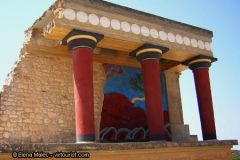
|
Palace of Knossos, Greece, ca. 1700 - 1400 BCE
central courtyard w/ flanking rooms open air chambers labyrinthine ground plan columns - red/ white, wood, taper smaller at bottom capitals - black |
|
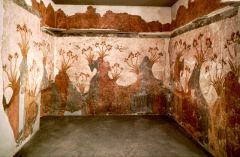
|
Spring Fresco, Akrotiri, Thera, Greece, ca. 1650 BCE. Fresco, 7' 6" high
one of the earliest pure landscapes in existence joyful patterns of undulating lines and fanciful plant forms dominate composition cheerful application of color simple shallows in air |
|
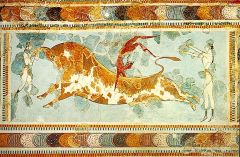
|
Toreador Fresco, Knossos, Greece, ca. 1450 - 1400 BCE. Fresco, 2' 8" high
ritual showing two women + man umping bull? males have darker skin thin waists, in profile sweeping curved lines painting |
|
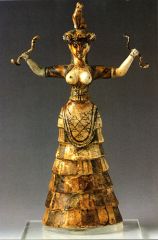
|
Snake Goddess, Knossos, Greece, ca. 1600 BCE. Faience, 1' 1.5" high
goddess? Fertility image? minoan thin waist, breast skirt in layer, apron on top wide-eyed snakes in each hand |
|
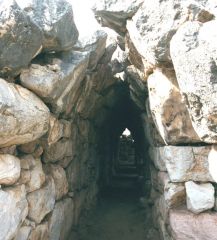
|
Corbelled Gallery, Tirynes, Greece, ca. 1400 - 1200 BCE
cyclopean masonry, projects power corbel vault walls look massive but actually tight spaced |
|
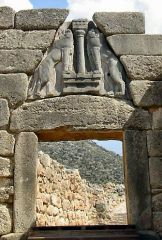
|
Lion Gate, Mycenae, Greece, ca. 1300 - 1250 BCE. Limestone, relief panel 9' 6" high
triangular group over doorway, early pediment on a post-lintel gate lions? column narrow, tall passage way for defense |
|
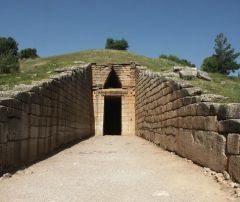
|
Beehive Tomb, vault of the tholos of the Treasury of Atreus, Mycenae, Greece, ca. 1300 - 1200 BCE
long entranceway tomb? corbel vaulted interior - largest till romans precision cutting of stone |
|
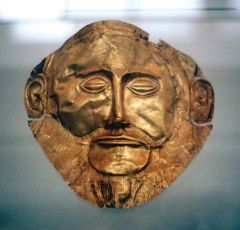
|
Funerary Mask, Grave Circle A, Mycenae, Greece, ca. 1600- 1500 BCE Beaten gold, 1' high
comes from royal shaft grave one of the first attempts at life-size sculpture in Greece |

